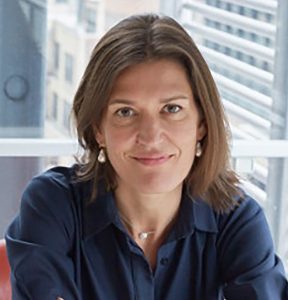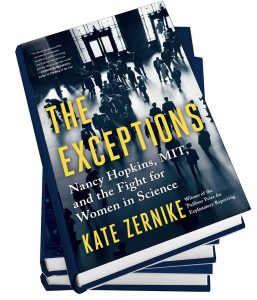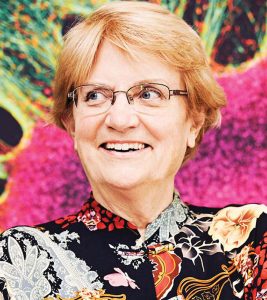I thought I knew the story of Nancy Hopkins’ battle against gender discrimination at MIT. I was working in a neuroscience lab at Harvard Medical School in Boston when the Boston Globe broke the story in 1999. We were riveted by how she, along with 15 other female faculty members, had collected and presented irrefutable evidence of gender inequality to the MIT administration. In doing so, the women convinced the ivory tower that the school was discriminating against women on the faculty. In turn, MIT admitted that it was at fault.

To women in science, Hopkins was an instant hero. What she and the women by her side had done was unprecedented. But we didn’t know why Hopkins had embarked on this mission, although we could guess. (It requires little imagination.) But now we know. The full story is documented in The Exceptions, a new book written by Kate Zernike—the reporter who broke the story 24 years ago.
The story Zernike tells is one of discrimination against women in science. And because of her extraordinary achievement, Hopkins will go down in history as a champion who fought to make things more equitable for women in STEM. But the story is more than that. More accurately, it is the story of a scientist who wanted nothing more than to do her research. And she wasn’t willing to let anything stand in her way.
Needing space

The Exceptions begins with Hopkins’ childhood in New York City and her early education at two prestigious institutions, the Spence School and Radcliffe College. Her scientific training started when she was an undergraduate student working with Nobel laureate James Watson in Harvard College labs, and continued when she was a graduate student working with Mark Ptashne. Although Watson is notorious today for his improprieties, he is remembered in the book as an incredibly supportive mentor of Hopkins. He helped her climb the ladder as an early investigator, and he remained a constant source of support throughout her career.
Hopkins joined the faculty of MIT in 1973 as an assistant professor. Her research focused on cancer genetics—the effect of retroviruses and enhancers on the genome and how they shape cancer biology. Later in her career, she continued her passion for unpacking genetic complexity but switched her focus to zebrafish. This powerful new animal model allowed her to start asking questions about genetics and development.
 As Hopkins became more established as an investigator, her challenges intensified. Perhaps the absence of Watson’s early protection was a factor, or perhaps she simply became more of a competitor for her male colleagues. For whatever reason, as she moved up the ranks, she was consistently pushed aside by her colleagues—isolated and marginalized.
As Hopkins became more established as an investigator, her challenges intensified. Perhaps the absence of Watson’s early protection was a factor, or perhaps she simply became more of a competitor for her male colleagues. For whatever reason, as she moved up the ranks, she was consistently pushed aside by her colleagues—isolated and marginalized.
For example, during her recommendation for tenure at MIT, despite being the department’s top choice, her name was surreptitiously moved down the list at the request of a prominent colleague. In addition, she was excluded from departmental meetings, she did not receive the same opportunities to apply for funding, she had the credit for one of her discoveries stolen by a male scientist, and she was not given the same amount of lab space as her colleagues.
The unfair allocation of lab space turned out to be the straw that broke the camel’s back. But because square footage can be readily determined, Hopkins had a clear course of action. In a classic story, she spent nights crouching in the dark, measuring the amount of lab space occupied by the faculty members in her department. Those data, in combination with other evidence, served as the basis for the report that would be shown to the MIT administration.
Over time, Hopkins became more and more siloed. Until, that is, she found other women on the MIT campus who were experiencing similar discrimination—the 15 other tenured women in the school of science at MIT. (At the time, 197 tenured men were there.) During a recent interview that I conducted with Zernike during the 2022 Rosalind Franklin Society annual conference, she related, “Nancy would not have done this without the other women, and they would not have done it without Nancy.” The power of the group was critical to their success.
Friends and foes
Zernike’s book introduces a large cast of characters (mostly men). Some of the men were friends to Hopkins, some were enemies, and some wore both hats.
Another character in the book is unconscious bias. Zernike told be that the idea for her book came about in 2018. Hopkins was retiring from MIT and wondering what to do with the notebooks she had kept during her career. Zernike recalled that the #MeToo movement was in its heyday. But she wanted to highlight a different kind of discrimination—not necessarily related to sexual assault. And she wanted to give readers a sense of what it feels like to face unconscious bias.
What rises to the top of the discrimination Hopkins experienced, and the extraordinary story of how she fought against it, is Hopkins’s dedication to a discipline that she loved. She slept, ate, and breathed science. Not because she had to and not because she wanted promotion. But because she loved it—it was her lifeblood.
Although Hopkins is a pioneer, she was not the first to call out the unequal treatment of women in science. Indeed, some 25 years earlier, in 1974, a group of women led by Alice Huang, professor emeritus at Harvard Medical School, analyzed data based on a survey sent to the members of the American Society for Microbiology. In the report, Huang and her coauthors wrote, “The lack of encouragement and self-confidence leading to isolation, which then leads to lack of recognition, is a vicious circle that must be broken for the woman professional.”
Nancy Hopkins broke that vicious circle on the MIT campus. One can only hope that more progress has been made over the past 24 years. However, recent data suggest that problems persist. For example, a 2019 study indicates that in the United States, women made up only 34% of those employed in STEM occupations. So, challenges remain, despite the progress secured by Hopkins, Huang, and many others. The Exceptions serves as inspiration to pick up where they left off.
For more on this story, please watch this interview with Kate Zernike, author of The Exceptions, conducted during the Rosalind Franklin Society Annual meeting last December.

Comments are closed.